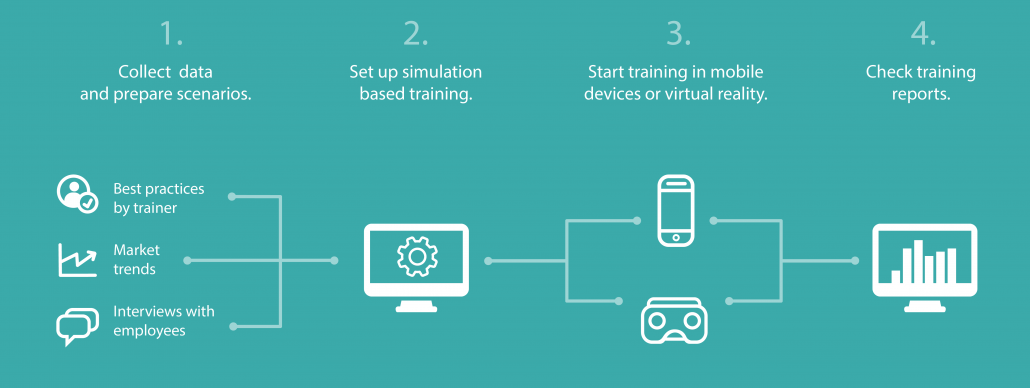Training employees require qualified trainers, time and, of course, money. There is no assurance that each employee receives the same level of know-how and will be fully prepared for their role. Entrepreneurs are now looking for solutions that are cost and time-effective. E-learning opened doors to self-paced learning and flexibility. Virtual reality offers automatization, individual approach and a safe environment for trial and error without consequences.
Is VR the future of e-learning?
We live in the world full of distractions. Attachment to our smartphones, checking out the e-mails, messages, notifications, scrolling the social media sites and reading the news caused a huge drop in the employee’s productivity. According to The Information Overload Research Group, distraction costs our economy around $997 billion annually. E-learning solves a lot of problems of a traditional classroom, yet it requires laptop or smartphone, what cause a new range of issues. Distraction is literally one click away.
Virtual reality, on the other side, usually requires a headset. A learner is immersed in the artificial environment. There is no space to wander the attention to Facebook or passively digest the information. VR also offers various scenarios that prompt the learner to find the best solutions. Imagine you’re training a customer support employee whose main job description is to communicate with clients. You can give them a pdf with questions and the best possible answers or you can do the role plays. VR offers an inexpensive and more effective alternative.
Supported by research and e-learning leaders
Studies suggest that VR is at least as effective as other forms of e-learning and a way more engaging. The interest rate for VR training is usually 50 % higher than for traditional forms of training. There is still a lot of research to be done. What we know now suggests that people react the same way to situations in virtual reality as they do in real life. This could also mean that they can retain the information from experience and recall it later when they need it.
Investors and tech companies see the potential in the future of VR learning. Goldman Sachs has forecast the growth of VR education up to $ 700 million by 2025. Udemy predicts that in 2018 the VR and AR (augmented reality) in e-learning will gain ground as costs come down, they also expect the growth of VR offerings from current 4% to 20% of all learning and development resources.
How are companies embracing VR in training employees?
Walmart is one of the pioneering companies who involved the latest technology in their training program for store associates – Walmart Academy. Thanks to VR they can prepare their employees for various situations they might face in their job and still provide the best shopping experience to the customers. Black Friday is one of those events when the thorough preparation is especially needed.
KFC took the employee training to a whole new level and made the onboarding VR experience little bit creepy, yet unforgettable. New employees are in VR closed in an escape room where they have to learn how to make signature KFC fried chicken. Narrator Colonel Sanders doesn’t make it easier for them. KFC understands that nothing can replace the real hands-on experience but VR initiation to KFC could speed up the learning process. The employees will definitely never forget their first experience of preparing the virtual chicken.
The rapid expansion brings a lot of challenges. Hiring a big number of employees in a short time span and losing the essence of the company are two biggest issues businesses are facing. Chain of healthy eateries, Honeygrow, identified potential risks of growing fast and distancing from their core values in the process. Their approach to expanding the business and avoid negotiating their original company culture involved the use of virtual reality. Honeygrow introduced VR to their training program in 2017 and they’re excited about the results. VR allows them to educate their employees continually, keep them committed to the company values, prepare them for challenges in their jobs and keep them engaged in a learning process.
How can you benefit from virtual reality in E-learning in your business?
The technical requirements for VR are usually the main factor slowing down the implementation of VR into the training program of employees. Comparing to a traditional approach to onboarding and training, VR still offers a cost-effective alternative. Prices for devices are expected to be dropping, the cheapest headsets cost already just a few dollars. Companies such as MindBox VR are offering platforms supporting VR for trainers to easily create VR training programs without a single line of code. MindBox VR platform, in particular, includes a unique voice recognition feature that allows the “real-life” interaction between the trainee and a virtual customer. Clients expect the ultimate solution that prepares the employees for their role in the company, simulation of a real-life conversation is especially beneficial for employees in sales and customer support departments.

VR allows you to create a distraction-free environment, full immersion into the topic and individual approach to learning. Companies see VR as a useful tool for onboarding and training new employees, improving the response of operators as well as increasing the customer satisfaction, continually educating their sales team and therefore boosting their sales results. According to Udemy, organizations nowadays are widely starting to use VR for training the soft skills. VR can be very useful for training employees in areas such as diversity & inclusion, communication with customers, negotiation, sales or even innovation and problem-solving. The trainers are completely free to create a training program that suits the company’s needs.
Udemy claims that VR and AR are set to be the biggest disruption to learning since the Internet. The next few years could be crucial for the development of VR as an integral part of e-learning industry worldwide
